This is a fortnightly newsletter about the New Zealand Net.
If you would like to be notified by email message when a new edition is published, please contact ZL1NZ.
You are also welcome to browse our newsletter archive.
Mystery key
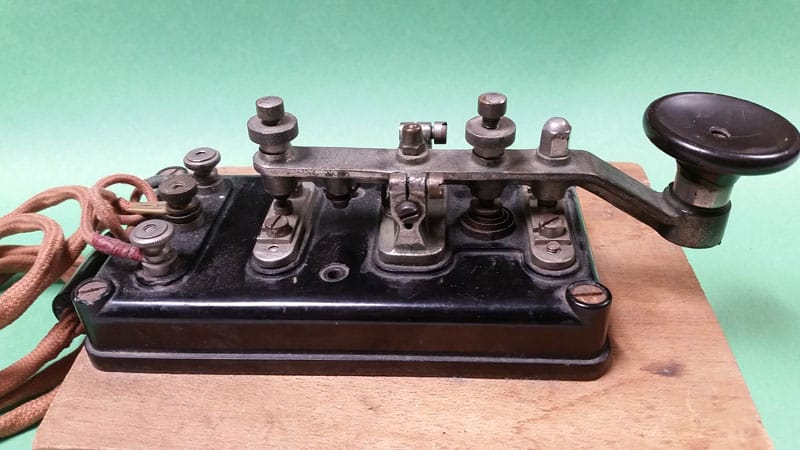
Do you recognise this unusual key? If so the owner would like to know what it is.
In the previous newsletter I asked folks to send me photos of their keys, and Dave VE3GSO in London, Ontario responded with this photo.
Dave says he bought it in the 1960s in Halifax, and he believes it was a ship’s spark-gap key, but it has no markings and – so far – no one has been able to identify it. Does it look familiar?
Quick notes
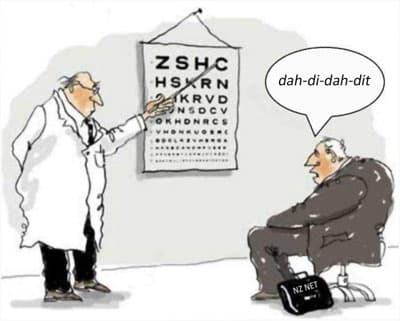
There might be a little more CW on the bands this weekend, with the CWops CW Open. The contest is in three 4-hour sessions: 0000-0359Z, 1200-1559Z and 2000-2359Z on 5 September.
Steve ZL2KE is back on the air and back on NZ Net after some home renovations that required him to disconnect his radio gear.
Ready to try your hand at Net Control? There are a few gaps on the Net Control roster in the coming weeks, so here’s your chance! Please contact me asap if you’d like to give it a go.
Tragedy at sea, again

Gulf Livestock 1 (left) and El Faro
This week’s loss of MV Gulf Livestock 1, during a voyage from Napier to China, with apparently only one survivor, has prompted comparisons with the sinking in 2015 of the US cargo ship SS El Faro. Both ships sank after sailing into cyclones and losing power.
In the case of El Faro, which went down near the Bahamas, a great deal is known even though there were no survivors. That’s because a submersible was able to recover the Voyage Data Recorder from the wreck, and its audio track, recorded via 6 microphones on the ship’s bridge, is powerfully reported in this magazine article.
As some of you will know, our good friend Manny VK3DRQ has first-hand knowledge of a ship losing power and sinking during a storm.
Net numbers
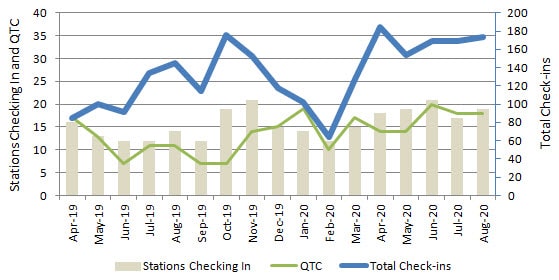
August ended with NZ Net session number 376, and although we didn’t break any records during the month, it was still a very good showing.
There were 174 check-ins (our third highest ever), 19 stations checking in, and 18 pieces of traffic handled. Here’s the monthly report, sent to all stations on 1 September.
NR60 R ZL1NZ 47/44 AUCKLAND 0900Z 1SEP20 = NZ NET = AUGUST QNI ZL1AJY 7 ZL1ANY 14 ZL1AYN 1 ZL1BWG 13 ZL1NZ 21 ZL1PC 2 ZL2GD 15 ZL2GVA 17 ZL2LN 7 ZL2WT 9 ZL4CU 12 ZL4FZ 5 ZL4KX 9 ZL4LDY 15 VK2IOW 1 VK3DRQ 21 VK3JS 1 VK4PN 3 LU1YFC 1 TOTAL 174 QTC 18 = ZL1NZ
Photo flashback
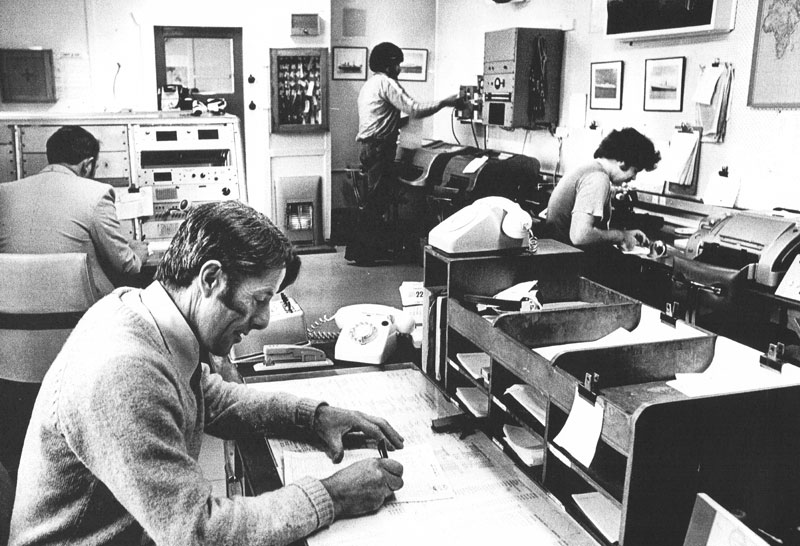
Wellington Radio ZLW operators in 1978
Morse musings
It’s interesting how CW abbreviations, punctuation and prosigns have evolved over the decades. Here are some examples of changes in punctuation:
Exclamation point
Currently, there is no “official” Morse signal for an exclamation point,* but until 1 September 1939 the exclamation point was dah-dah-di-di-dah-dah…
Comma
That old signal for an exclamation point is what we now regard as the comma, but until 1 September 1939 the comma was di-dah-di-dah-di-dah…
Full-stop (or “period” for our North American readers)
The old signal for a comma is what we now regard as a full-stop, but until 1 September 1939 the full-stop was di-dit di-dit di-dit
Why the changes?
As explained by Geoff Arnold G3GSR in Morsum Magnificat:
“The symbols were changed at the Cairo International Radio Convention (ITU) 1938, and became effective on 1 September 1939. The full-stop was changed because commercial printers produced it as III. The exclamation mark was abandoned because it was not used commercially, except for personal exchanges between operators.”
But wait, the exclamation point lives!
* Unofficially, some people regard <CM> (dah-di-dah-di-dah-dah) as an exclamation point. I have also seen some reference to <OE> (dah-dah-dah-dit) but that could be confusing, as it represents an accented “O” in several languages.
A remarkable radio amateur
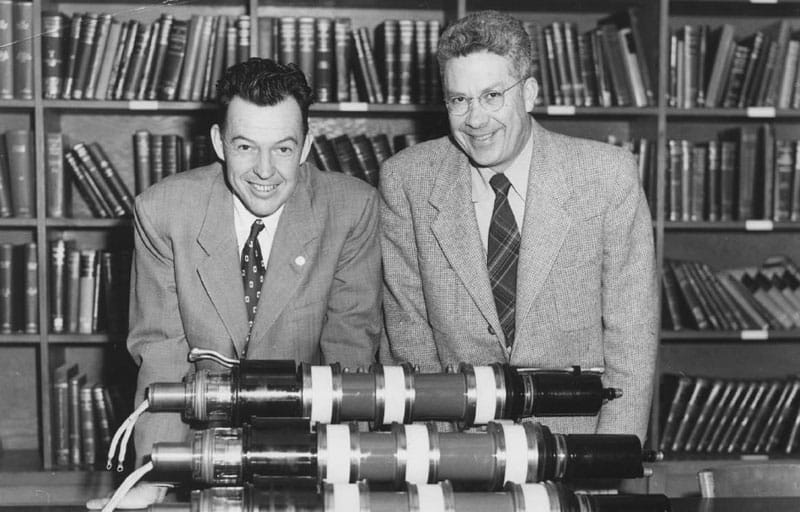
William Eitel and Jack McCullough with a high powered klystron in the early 1950s. Eitel-McCullough Inc
In 1932 two radio amateurs, Bill Eitel W6UF and Jack McCullough W6CHE, decided to build high power transmitters to work some of the 20 metre overseas stations being heard in California. They found to their dismay that the expensive transmitting valve they had purchased refused to work at 1000V – and that was all the voltage their power supply could provide.
They decided to make their own valves, and called their company Eitel-McCullough, or Eimac for short. Eimac became a very successful company, making valves for radio broadcast transmitters, but radio amateurs around the world also benefited from Eimac valves, including the famed 4-250, 4CX1000 and many more. Eimac was also active in producing high power klystrons for radar and was a major supplier to the US military during World War 2.
Bill Eitel’s interests in amateur radio were broad. He was an early driver and financial supporter of the OSCAR satellite project.
He was also devoted to CW. The story goes that he met his wife Laneil at a hamfest, where he was impressed by her bug fist!
Bill lamented the quality of some of the Morse he was hearing on the air in the 1970s, and wanted to encourage what he called “good morse.” He decided to start a group for operators that he considered to be the best of the best. He called it the Five Star Club, and to qualify for membership an operator had to be able to comfortably ragchew at a speed of (are you ready?) not less than 80 words per minute. I think it was a pretty small club. 🙂
A truly exceptional radio amateur, Bill Eitel died in 1989.
Scrambled signals
In the previous newsletter I asked if anyone could decode some sloppy morse from an old recording on the marine calling frequency 500 kHz. Gil ZL4CU responded, saying that it was a Russian vessel with callsign UKRQ calling Auckland Radio ZLD with traffic. ZLD acknowledged, and asked the calling station to go “UP” and wait.
What’s fascinating about this to me, is that I copied the vessel callsign as UNCQ – which just goes to show that the dits and dahs were there, but the spacing was confusing.
Gil assures me he’s copied worse fists in his time as a coast station operator. 🙂
For our next challenge (and a virtual chocolate fish), can you tell me the meaning of the following prosign? It won’t look familiar because I have not used its usual digraph (combination of two letters) to represent it. So you’ll need to sound it out.
Hint: it’s not one we hear very often.
<PN>
And there’s a second virtual chocolate fish if you can tell me how this prosign is usually denoted (i.e. its usual digraph).
Email your reply or, even better, send a radiogram to ZL1NZ via NZ Net!
I always suspected that Sheldon was a ham. Did you notice that he often wore a t-shirt with “73” on the front?
Net tip: How to QNG
If Net Control asks you to QNG1 (make 1 CQ call as temporary Net Control) and you pick up one or more stations while doing so, please be sure to report the results to Net Control, who many not have copied the stations that called you. Other stations on the Net may not have copied either.
You could send something like this:
QNI QRU FM ZL1ABC ZL2DEF ZL3GHI BTN
or
QNI QRU FM ZL1ABC = QNI FM ZL3GHI QTC1 ZL4JKL BTN
Suggestions?
If you have suggestions on how to make the NZ Net better, or things you’d like to see covered in these updates, please contact ZL1NZ. You might even like to write something for the newsletter.
Thanks for reading, and I hope to see you soon on the NZ Net!
—
Neil Sanderson ZL1NZ, Net Manager
New Zealand Net (NZ NET)
3535.0 kHz at 9pm NZT Mon-Fri


